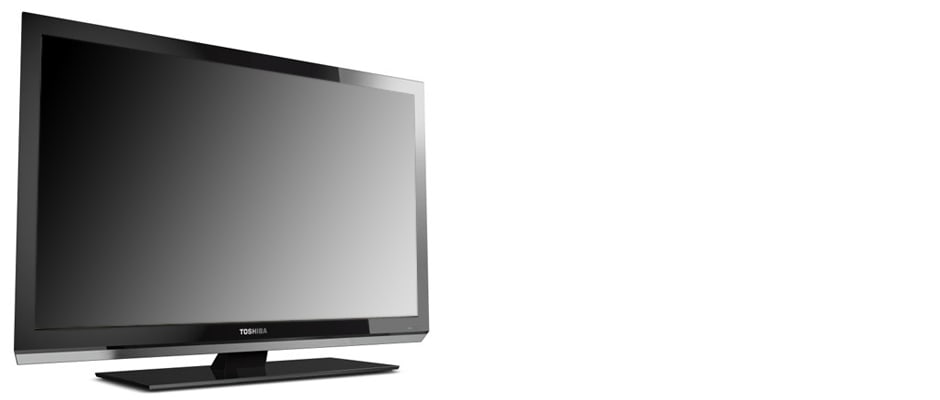Pros
Cons
Introduction
Overall Design
{{section_header}}{{section.name}}{{/section_header}}
The design of the {{product.name}} is fairly slick as far as televisions go, with a minimalist bezel and a very thin profile. You don't have to worry about a horrifyingly ugly bezel, as this TV is easy on the eyes.
Front
{{section_header}}{{section.name}}{{/section_header}}

Back
{{section_header}}{{section.name}}{{/section_header}}

Sides
{{section_header}}{{section.name}}{{/section_header}}

Remote Control
{{section_header}}{{section.name}}{{/section_header}}
Television enthusiasts who lament the rapid inflation of remote control size will love the tiny remote included with the {{product.name}}. While it is small, it doesn't seem to skimp on functionality, and although the key travel can be a little annoying, you won't have to battle with the remote to get it to record your commands.

In the Box
{{section_header}}{{section.name}}{{/section_header}}
Your brand new {{product.name}} comes packaged with an instruction manual, remote, batteries, a stand, and assorted documentation.
Black Level
{{section_header}}{{section.name}}{{/section_header}}
We usually ascribe the judgment of "good" to any TV that has a deepest black of less than 0.1cd/m2, and the {{product.name}} doesn't disappoint here: with a deepest black of 0.08cd/m2, the {{product.model}} does fairly here. More on how we test black level.
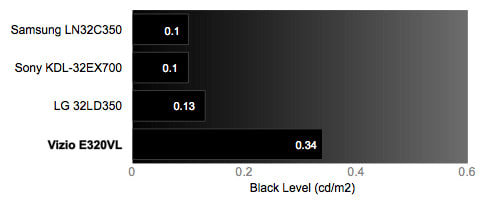
Peak Brightness
{{section_header}}{{section.name}}{{/section_header}}
When viewing content in a brightly-lit room, you will typically only need a screen brightness of 200cd/m2, but the {{product.name}} can display a picture of up to 367.37cd/m2, which is more than overkill. More on how we test peak brightness.
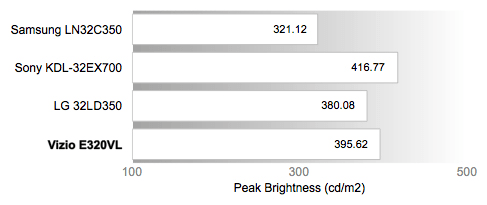
Contrast
{{section_header}}{{section.name}}{{/section_header}}
Because of the good depth of blacks and the respectable peak brightness, the {{product.name}} nets a very wide contrast ration of 4592:1. Wider contrast ratios mean more values along the greyscale the TV can reproduce, and it is very important to have a good contrast ratio for those who demand high picture quality. More on how we test contrast.

Tunnel Contrast
{{section_header}}{{section.name}}{{/section_header}}
The {{product.name}} managed to keep a relatively even level of black on the screen no matter how much or how little area it occupies. More on how we test tunnel contrast.
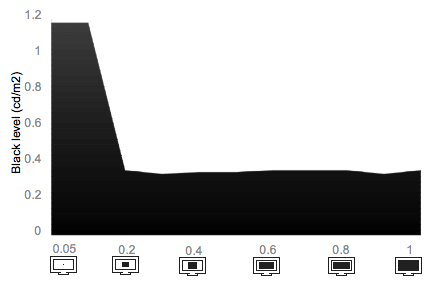
White Falloff
{{section_header}}{{section.name}}{{/section_header}}
The {{product.name}} manages to keep a consistently bright level of whites on the screen too, no matter how much or how little area white occupies on the screen. More on how we test white falloff.
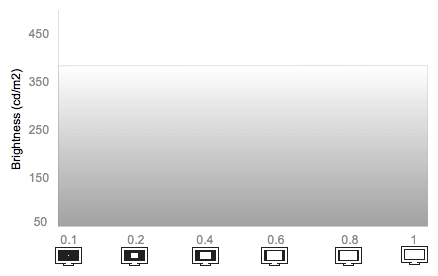
Uniformity
Greyscale Gamma
{{section_header}}{{section.name}}{{/section_header}}
When we test greyscale gamma, we look at two aspects of our charts before scoring a TV’s performance: the smoothness and slope of the line. The smoothness of the line tells us whether or not there were certain values of signal intensity that the TV simply couldn’t produce, or if they were produced incorrectly. Ideally, the slope of the line should lie somewhere between 2.1 and 2.2, but depending on a TV’s performance, this may vary. If it does, that means it doesn’t quite produce the ideal values along the greyscale, which can result in lost detail, especially in shadows.
The {{product.name}} nets a decent score here, but we've seen better. Though for the most part the gamma curve is smooth, it does have some minor issues with incorrect values (you'll see these as color bands or artifacts in shadows) near the darkest range of signal intensity. As far as the slop of the line goes, it seems to vary a little bit depending upon where in the line you catch it, but an average slop of 2.58 isn't horrendous. More on how we test greyscale gamma.
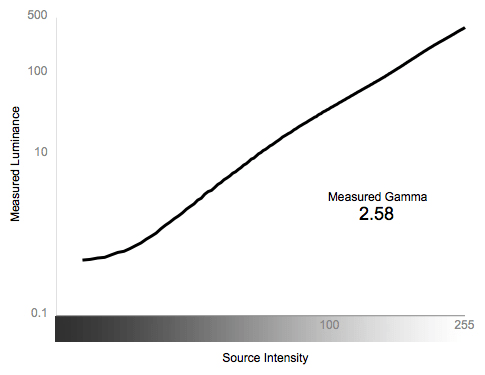
Color Temperature
{{section_header}}{{section.name}}{{/section_header}}
For all but the darkest end of signal intensity, the color temperature error is actually unable to be seen by the human eye. Once you get to darker pictures, however, the {{product.name}} seems to warm the picture enough to be seen, only if you know what you're looking for. It was enough to knock its score down a little bit, however. More on how we test color temperature.

RGB Curves
{{section_header}}{{section.name}}{{/section_header}}
The {{product.name}} has a beautiful RGB color curve response, despite a minor peaking problem towards the brightest end of signal intensity. It's not too noticeable, but you may notice a tiny bit of color banding in shadows. Outside of this, you shouldn't notice any errors in colors along the vast majority of the range of signal intensity. More on how we test RGB curves.

Below are linear representations of the RGB curves shown above, as matched against the comparison models. Take note of any color banding, which indicates errors along the RGB curves of that particular TV set.
Motion Performance
{{section_header}}{{section.name}}{{/section_header}}
It doesn't dazzle its viewers with exceptional motion performance, but the {{product.name}} does well enough for an entry-level television's performance. While there are no major issues, the {{product.name}} seems to struggle a little bit with maintaining detail in moving pictures, as it tends to create a few barely-noticeable artifacts. Though turning the "Clear Frame" processing on will eliminate these issues, it will also make your picture look quite bizarre in many instances, victim of the Soap Opera Effect. More on how we test motion performance.
3:2 Pulldown & 24fps
{{section_header}}{{section.name}}{{/section_header}}
Despite its lackluster performance with motion, the {{product.name}} does very well in handling 24fps film content. In our test patterns, there was none of the hallmark strobing or flashing that plague lesser TVs. These problems usually arise from poor handling of content conversion from 24fps to 60Hz (the native refresh rate of televisions in the US). More on how we test 3:2 pulldown and 24fps.
Resolution Scaling
{{section_header}}{{section.name}}{{/section_header}}
Because the {{product.name}} has a native resolution of 1080p, and not all signals from consoles, media sources, and other content isn't always exported to the TV in the same resolution, the {{product.model}} must re-scale the picture to fit to the screen. Below is a summary of how well it handles each resolution. More on how we test resolution scaling.
480p
While there was some vertical overscan (3%), problems eith legibility, high-frequency patterns, and false coloration were virtually nonexistent.
720p
The picture is clipped by 2% on all sides, and shows some interference in high-frequency patterns.
1080i
Though the picture is kept relatively intact, there is noticeable false-coloration in high-frequency patterns.
Formats
{{section_header}}{{section.name}}{{/section_header}}
The {{product.name}} has a native resolution of 1080p and supports all standard NTSC resolutions.
Viewing Angle
{{section_header}}{{section.name}}{{/section_header}}
LCD TVs typically have poor viewing angles, but that of the {{product.name}} is bad. Oh so terribly bad. On the upside, testing was short, but consumers will immediately notice their contrast dropping more than 50% less than 10 degrees away from center on either side. You probably don't want to use this TV if you watch in large groups often.

Reflectance
{{section_header}}{{section.name}}{{/section_header}}
We were pleasantly surprised that the {{product.name}} is not as reflective as some of its mirror-like brethren, but it still has a somewhat annoying reflection pattern. It manages to cut down the reflection angle pretty well, but the light source will be very clear if it's shining directly on it. We suggest facing this set away from windows.
Video Processing
{{section_header}}{{section.name}}{{/section_header}}
Probably one of the most surprising thing about the {{product.model}} is how few video processing modes it has. Outside of the frame interpolation and noise reduction, there really isn't much in the way of anything that changes you viewing experience drastically.
Calibration
{{section_header}}{{section.name}}{{/section_header}}
The {{product.name}} is surprisingly easy to calibrate. After enabling the Movie picture mode on the TV, we adjusted the picture of the {{product.model}} for maximum performance. Looking at the chart below, you'll note that we made mostly minor changes to how Toshiba calibrated the {{product.model}}, and we turned off all additional video processing, as usual.

All of our calibration is done in conjunction with the DisplayMate software.
](http://www.displaymate.com/)
Video Modes
{{section_header}}{{section.name}}{{/section_header}}
The {{product.name}} has a handful of video modes, each more suited to a different viewing condition than others.
Connectivity
{{section_header}}{{section.name}}{{/section_header}}
While it doesn't have the most input ports we've seen this year, the {{product.name}} should get the average entry-level user where they need to go. With 3 HDMI ports and one hybrid composite/component video input, most users should be able to connect their media sourced of choice with no problem. If you're not satisfied with the audio of the {{product.name}}, you can hook up your sound system easily with either the analog or digital audio out options.

Placement
{{section_header}}{{section.name}}{{/section_header}}
The ports are spread out over the back of the set, and the panel that holds the analog options is a giant pain in the neck, but the side-facing input panel is quite nice, with a wide selection of ports to use. Still, it's worth mentioning that the ports on the back of the set are wretchedly difficult to access without a swiveling base.
Audio Quality
{{section_header}}{{section.name}}{{/section_header}}
Audiophiles will shriek and shrivel away from the TV set in horror at the tinny, distorted sound, but the digital and analog audio out options allow users to employ their own sound systems. It's a good thing too, because the audio of the {{product.name}} is just bad. If you are forced to use the on-board sound system of the {{product.name}}, it'll work fine for daytime talk shows, but watching movies on it will not trick you into thinking you're in a movie theater.
Menu Interface
{{section_header}}{{section.name}}{{/section_header}}
Possibly one of the more refreshing things about this TV is how simple the menu system is. It's mostly due to there being extremely few options, but the structure of the menus is intuitive and simple to navigate, if a bit ugly.

Advanced menus follow the same patterns and structure of the main menus on the {{product.model}}, in aesthetic and navigation.

Instruction Manual
{{section_header}}{{section.name}}{{/section_header}}
Upon opening the box of the {{product.name}}, you'll notice a smallish manual included along with all the documentation you get with the TV set. Upon opening it, you'll discover a rather tersely-worded tome that while informative, isn't special or easy to look at. It's logically ordered and organized, but you might fall asleep while searching for answers. You may want to find a version of it online, if only to search for keywords.

A manual for so many TV models, they have to be further categorized by type.
Local Media Playback
{{section_header}}{{section.name}}{{/section_header}}
Using the lone USB port on the side of the television, you can play back either a collection of JPEGs or MP3s, but no other file formats. The playback mechanism is a bit clunky, and there are only very limited playback options, but you could do worse. This probably isn't so good for using as an ambient content source at a party or anything.

Other Media
{{section_header}}{{section.name}}{{/section_header}}
The {{product.name}} does not support any other media.
Power Consumption
{{section_header}}{{section.name}}{{/section_header}}
Despite its size, the {{product.name}} manages to draw a very low amount of power that shouldn't make a notable difference to your power bill. Assuming average usages and electricity prices, you can expect to pay around $9.37 over the course of a full year in power costs, which is great as far as TVs usually go. Were you to get a plasma screen, you could expect to pay a lot more.
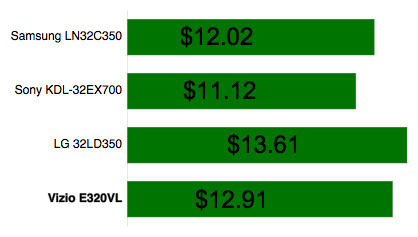
Value Comparison
{{section_header}}{{section.name}}{{/section_header}}
The {{product.name}} is slightly cheaper than the Samsung UN46D6000, and has a better contrast ratio and slightly better color accuracy. The big difference we see here is that the Samsung is a Smart TV, providing it's owner with streaming online content, a feature that generally adds about $500, and is only about a $150 difference here. Considering the Samsung Smart Hub is the best online menu system we saw this year, we say the extra money is worth your investment.
Blacks & Whites
{{section_header}}{{section.name}}{{/section_header}}
Beating a Samsung in contrast ratio is a noteworthy feat. At this price point, a contrast ratio of over 4000:1 is spectacular, great bang for your buck. If you have the time, check out the gamma curves for each of these models and you will see that in addition to a better contrast ratio, this Toshiba uses more values in its expanded range, transitioning more smoothly from one value to the next than the Samsung.

Color Accuracy
{{section_header}}{{section.name}}{{/section_header}}
Both of these TVs had great color temperature readings, except for some tinting into cooler temperatures at the darkest end of the spectrum. Nothing so obtrusive though, you probably won't notice any difference in your picture.
The color curves on both of these sets were spectacularly smooth. The Toshiba had a better overall curve to the lines, showing that the change of values is even. The difference between the dark, middle and light values will be predictably consistent for a great picture. On the Samsung, the brightness of colors stays too dim until it increases significantly to the brightest possible values. The jump in difference will render the colors picture too dim or too bright for most of the spectrum.
Motion
{{section_header}}{{section.name}}{{/section_header}}
Samsung has one of the best processors for handling motion on the market. The engineering in their mid-range to high-end models is rarely rivaled. This Toshiba does just fine though. It won't startle you with detail retention, but you won't be upset with your picture.
Viewing Effects
{{section_header}}{{section.name}}{{/section_header}}
Both of these televisions are LCD displays, which have poor viewing angles for retaining a strong contrast ratio. This Toshiba is noticeably worse than the competition however. If you have a large room and a big family, you may want to check out the Samsung, which falls in the middle of the range.
Connectivity
{{section_header}}{{section.name}}{{/section_header}}
You get an extra HDMI port and a couple more analog audio ports on the Samsung. More importantly, the Samsung has wireless connectivity, allowing you access to the best DLNA menu system this year. For a few more spondulicks, the online content is definitely worth it.
Value Comparison
{{section_header}}{{section.name}}{{/section_header}}
For about $100 more, you will have a Smart TV if you buy the LG. However, if online content seems frivolous to you, the Toshiba displays a better picture with more accurate colors and a largely better contrast ratio.
Blacks & Whites
{{section_header}}{{section.name}}{{/section_header}}
The LG in this comparison had a disappointing black level. Its deepest black is more of a very dark gray actually. This hurt the contrast ratio pretty badly, the Toshiba showing it up by more than 4:1.

Color Accuracy
{{section_header}}{{section.name}}{{/section_header}}
Perfect color temperature is a rarity, like a flawless gem, and we saw it when we tested the LG 42LV5500. Our Toshiba here was pretty close to perfect, but it displayed some cool tinting to images from the darkest end of the spectrum.
In terms of color production from darkest to brightest, the Toshiba transitioned more smoothly and had a better overall consistency to the difference between values.
Motion
{{section_header}}{{section.name}}{{/section_header}}
The TruMotion feature on the LG showed proved to handle out motion tests with ease. However, we generally recommend that you turn these features off when watching film-based content, as it makes the motion overly smooth, appearing to be shot on a home camera. The Toshiba did very well in these tests also, with no processing features. With TruMotion disengaged, these sets are about even.
Viewing Effects
{{section_header}}{{section.name}}{{/section_header}}
Viewing angle was a real strong point for the LG in this face off. Retaining a strong contrast ratio up to almost 45º off center, this LG is something special for an LCD model. Conversely, the Toshiba 46SL412U has a very sad viewing angle, even for the typically narrow range of an LCD.
Connectivity
{{section_header}}{{section.name}}{{/section_header}}
The LG has a couple more analog ports and another HDMI port that would be useful if you have a whole bunch of devices to connect. Like the Samsung in the other comparison, this LG has online connectivity via adapted wireless. LG was runner up for best online content interface this year and if you can spend a little bit more, the extra connectivity seals the deal.
Value Comparison
{{section_header}}{{section.name}}{{/section_header}}
We like the Toshiba over the Sony here. For an extra $100, the Sony has a better contrast ratio, but that is where the advantages end. Save your money and get a better performer out of the Toshiba.
Blacks & Whites
{{section_header}}{{section.name}}{{/section_header}}
For an LCD screen, this Sony has a really impressive black level of 0.04 cd/m2, a point of quality we usually only see on plasma screens. This low black level manifests a contrast ratio of over 7000:1, meaning that it uses a vast range of black and white values to describe a beautiful picture. The Toshiba is still good, but next to this Sony we ask, Toshiba who?

Color Accuracy
{{section_header}}{{section.name}}{{/section_header}}
The color temperature of the Toshiba only breaks the error limit at the darkest end of the spectrum and not by much. You may notice some slight cool tinting in the darkest images, but not much. The Sony here is nearly perfect, but the difference should not be greatly noticeable.
On the other hand, the color curves for the Toshiba were almost exactly accurate, besting the Sony which had some trouble with smoothly transitioning from one value to the next.
Motion
{{section_header}}{{section.name}}{{/section_header}}
This mid-range Sony did not have the advanced motion processing features of its high-end brethren, and therefore did not blow our tests out of the water. Without processing features, these two televisions performed on the same level.
Viewing Effects
{{section_header}}{{section.name}}{{/section_header}}
The Toshiba has a really narrow viewing angle. Even this Sony with a tight little range is a better choice for wide angle viewing.
Connectivity
{{section_header}}{{section.name}}{{/section_header}}
With no internet features to speak of, the Toshiba wins out with an extra HDMI port. Having only two HDMI slots, like what the Sony offers, is limiting. You will be using HDMI 1 for cable, HDMI 2 for either your DVD or Blu-ray player, and then there is no space for gaming or other devices.
Conclusion
With good contrast and color performance, the {{product.name}} impresses for its price point, but it's not perfect. With a lackluster audio system, cinephiles will probably want to use an external setup to avoid the tinny playback.
A basic television in most regards, there are no frills with the xxSL412U series of Toshiba televisions, but for their price they will give you exactly what a consumer wants in an entry-level TV: value. For a lowish price, the {{product.model}} offers a decent range of connectivity options, but solid performance where it counts.
There are some advantages that can be gained from looking for more expensive TVs, however, as the {{product.name}} has no internet connectivity and very limited external media options if you like viewing slideshows or playing music through your set. If you are a streaming junkie, you might want to look elsewhere to sate your content appetite, unless you have an external device to handle that sort of thing. If not, this set should be among the models you take into consideration.
Model Series Comparison
{{section_header}}{{section.name}}{{/section_header}}
The xxSL412U series of televisions include the 55SL412U, 46SL412U, and the 40SL412U. All are LED-backlit TFT screens with comparable connectivity and performance. All three screens lack internet connectivity and much in the way of local media playback.
Photo Gallery
{{photo_gallery "Front Tour Image", "Back Tour Image", "Sides Tour Image", "Stand Photo", "Controls Photo", "Remote Control Photo", "Connectivity Tour Image 1", "Connectivity Tour Image 2", "Connectivity Extra Photo", "Menu Main Photo", "Menu 2 Photo", "Internet Features 1 Photo", "Internet Features 2 Photo", "Internet Features 3 Photo", "Local Media Playback 1 Photo", "Local Media Playback 2 Photo"}}
Ratings & Specs
{{manufacturer_specs_table}}
Meet the tester
A seasoned writer and professional photographer, Chris reviews cameras, headphones, smartphones, laptops, and lenses. Educated in Political Science and Linguistics, Chris can often be found building a robot army, snowboarding, or getting ink.
Checking our work.
Our team is here to help you buy the best stuff and love what you own. Our writers, editors, and experts obsess over the products we cover to make sure you're confident and satisfied. Have a different opinion about something we recommend? Email us and we'll compare notes.
Shoot us an email